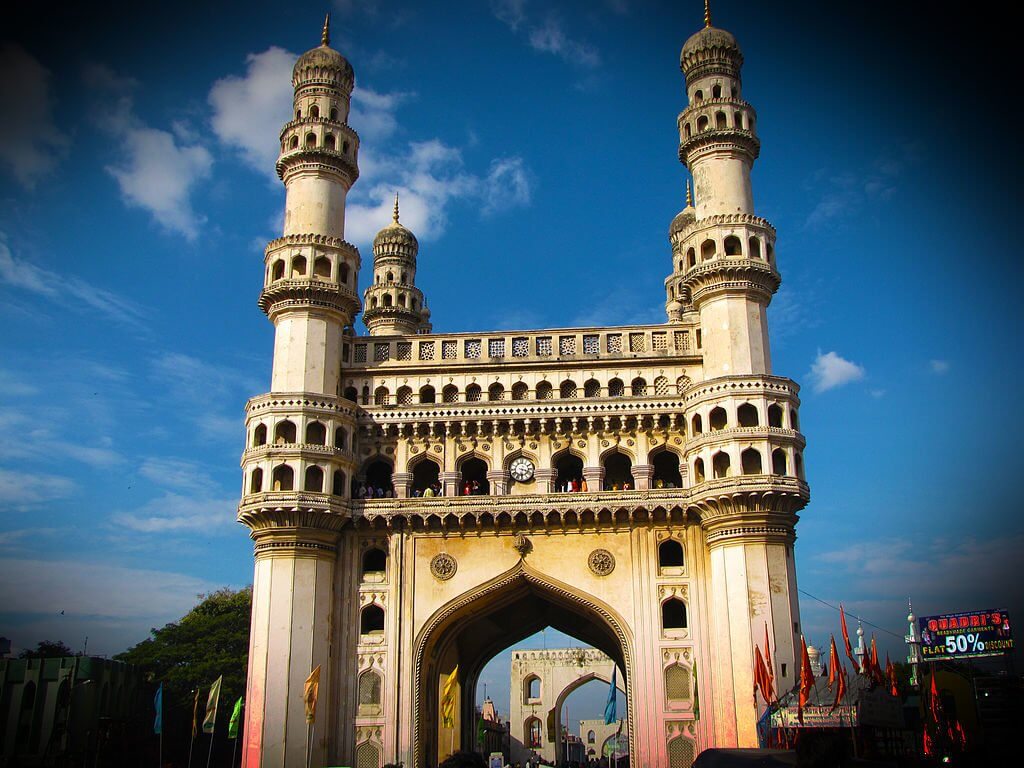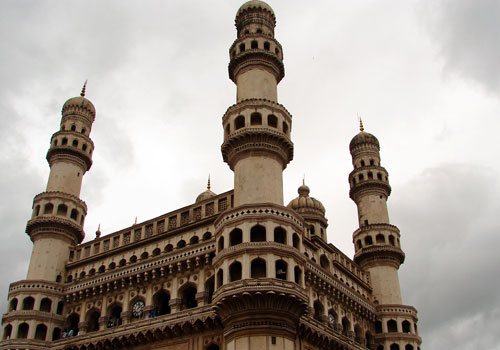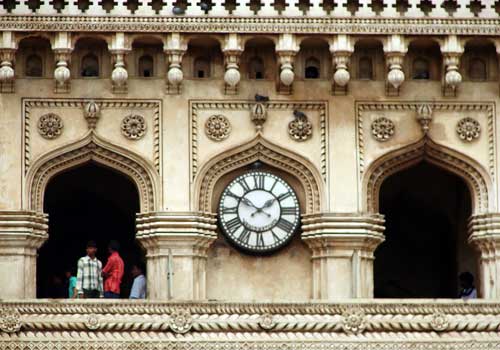Charminar

Charminar Entry Fee
Charminar Timings
| Day | Timing |
|---|---|
| Monday | 9:30 am – 5:30 pm |
| Tuesday | 9:30 am – 5:30 pm |
| Wedesday | 9:30 am – 5:30 pm |
| Thursday | 9:30 am – 5:30 pm |
| Friday | 9:30 am – 5:30 pm |
| Saturday | 9:30 am – 5:30 pm |
| Sunday | 9:30 am – 5:30 pm |
The capital city of Telangana, Hyderabad is a popular tourist destination and presents its visitors with a mesmerising contrast of age old traditions, culture at one end and modern facilities, amenities of a metropolitan city at the other end. Hyderabad is one city, which has no dearth of tourist attractions.
The very well known Charminar of Hyderabad is located at the Old City. This square shaped structure with a height of 56 m and breadth of 30 m was constructed in 1591. It was built by Sultan Mohammed Quli Qutb Shah in the honor of his wife Bhagmati.
Also referred as the ‘Arc de Triomphe of the East’, Charminar is adorned with four towers in each corner. The minarets on each side, is of 48.7 m height, each with four storeys. Chaminar has a small mosque as well on the top floor. There are 45 prayer spaces which are still visited by people, particularly on Fridays. Lighting in the evening is quite glamorous and makes for a worth watching site.
Undeniably the most prominent landmark of Hyderabad, Charminar has rightly been called as ‘Arc de Triomphe of the East’. It is also called as the ‘Mosque of the four minarets’. Not visiting this magnificent architecture while on a Hyderabad tour is nothing less than a sacrilege, especially if you are a travel enthusiast. Not only of Hyderabad, Charminar has become an iconic monument for entire India. An Urdu word, Charminar, means four turrets (char- four, minar-turret).
As suggested by its name, Charminar does have four exquisitely carved pillars, one of each side. This impressive structure stands calmly amid the hustle bustle of Laad Bazaar of the Old city. Maintained by the Archeological Survey of India, Charminar is a representation of the historical background of the city, its glamour, glory and cultural richness. Since its construction in 1591 by Mohammed Quli Qutub Shah of Shah Dynasty, Charminar has been captivating every visitor, with its architectural beauty as well as religious and historical significance.
History of Charminar
Charminar was built by Sultan Mohammed Quli Qutb Shah in the year 1951. It is said that this square shaped structure with four pillars and intricate carvings was built in honour of his wife, Bhagmati. However, the actual reason behind building Charminar is still not clear.
As per a popular belief, Charminar was built to acknowledge the elimination of the plague which had affected the entire city immensely during that era. It is believed that Sultan had prayed for the end of this plague with which his people were suffering. Hence, as the plague ended, he built the charminar as a tribute to Allah. The four pillars are also said to be dedicated to the first four caliphs of Islam.
It is also said that it was built in the memory of Prophet Muhammed’s son in law who lost his life at the battle of Karbala as its design is in the shape of Shiya Tazias. Some also believe that location of Charminar is the place where Sultan had seen his then future wife Bahgmati for the first time.
As per a French traveller, Jean de Thévenot who travelled in the 17th century, the reason of its construction is entirely different. According to his narration which is in sync with the Persian texts as well, Charminar was built to commemorate the start of second Islamic millennium.
The inscription on the foundation stone is translated as ‘Fill this my city with people as, Thou hast filled the river with fishes, O Lord.’ This also indicates that the monument was built to mark of the city’s foundation as well. As per the historian Historian Mohammed Safiullah, Charminar was built as an epicenter of Hyderabad.
The construction began in 1589 and was completed in two years with a cost of Rs. 9 lakhs, which was around 2 lakhs huns/gold coins in those times. It is said to weigh around 14000 tones with a minimum of 30 feet deep foundation. In 1670, a minaret had fallen down after being struck by lightning. It was then repaired at a cost of around Rs.58000 then. In 1820, some part of it was renovated by Sikandar Jah at a cost of Rs. 2 lakhs.
There is another legend associated with the Charminar according to which, there is a secret underground tunnel that connects Charminar to the Golconda Fort. It was built for the royal family, to escape in case of any kind of emergencies. However, till date no tunnel could be found.
Charminar Hyderabad, Image Gallery




Architecture of Charminar
An Iranian architect Mir Momin Astrawadi, who had settled in Hyderabad, designed Charminar. It presents an imposing structure which has clearly withstood the test of time. It is a square shape monument with four pillars, one on each side. The architectural design of Charminar is inspired from the Shia "tazias". These Tazias were built in the memory of Hussain, who was the son in law of Prophet Muhhamed and had lost his life in the battle of Karbala.
The square shape of the monument measures 20 meters on each side. Each side of the monument is 11 meter wide and overlooks at the four prominent thoroughfares. Charminar has been built with granite and lime mortar.
The four pillars around Charminar represent the four caliphs. These pillars or minars are 48.7 meters high. These are four storied, with each floor divided by intricately carved rings that surround it. On the top floor of Chaminar there is a mosque which is believed to be the oldest mosque of Hyderabad city. There are 45 prayer spaces or musallah. Attached to these is the open space which can be used to accommodate more number of people on occasions like Friday prayers or festival. It is located at the western end of the monument’s roof. It can be reached via 149 winding steps. The view from the top is also breathtaking.
In the middle of the Charminar courtyard, you will find a small vazu with a small fountain, which has been built to provide water for the ablution before offering prayers.
One can also notice the signature motifs of Qutub Shahi buildings on Charminar. The manner with which each pillar has been built makes it appear as a lotus leaf. The arches around the structure does lead to slightly shorter appearance when in comparison to the minars. In the year of 1889, four clocks were also added on all the four sides of the structure.
Places to visit near Charminar
What adds more charm to the visit to this historical monument is the proximity it enjoys with many other popular tourist attractions in Hyderabad.
Mecca Masjid/Makkah Masjid- It is located quite close to Charminar. Hence, when visiting the monument art lovers can also plan a visit to this ancient mosque. The structure of Makkah Masjid beautifully represents the architectural style of Qutub Shahi Dynasty.
Laad Bazaar- Another popular place to visit when at Charminar is the Laad Bazaar. Not just a place for shopping lovers, this historical market is an ideal place for photographers as well. Also known as Choodi Bazaar, this is an ancient market dedicated especially for glass and lacquer bangles. This market dates back to the time of Nizams and Qutub Shahis.
From Charminar you can visit many other prominent sightseeing places as well. Chow Mohalla Palace which is only 10 minutes of walk from here is the most porniment one. Some of other places to visit are Kali Kaman, Patthar Gatti and Shahali Banda.
Entry Fee and Timings of Charminar
The entry fee for charminar is minimal for Indian visitors, i.e. Rs.5 per Indian tourist while for tourists belonging to other countries, the Charminar entry fee is Rs.100 per person.
The Charminar timings are from 9.30 AM to 5.30 PM. it is open to visitors on all days of the week.
Although, one can visit this marvelous piece of architecture throughout the year, the best time to visit Charminar is from the months of October to March as the weather is pleasant for sightseeing. Do make sure that you visit Chaminar in evening at least once to witness the lighting of the structure and the sparkle of Laad bazaar which is located a few steps away.
How to reach Charminar
Charminar is one of the most prominent landmarks of Hyderabad city hence reaching here is extremely easy even for first time visitors. Located on the Charminar road, Char Kaman in the Ghansi Bazaar, it can be reached via auto rickshaws and taxis.
There are many TSRTC buses that operate from major bus stands and railway stations of the city to Charminar. The distance between Charminar and Hyderabad bus stand is 5 km.
Interesting Facts about Charminar
- In 2010, Lindt chocolatier Adelbert Boucher designed a chocolate replica of Charminar weight fifty kilograms. It was displayed at The Westin, on 25th and 26th September. This was done as a tribute to the iconic Charminar.
- It is said that Charminar was the first building of Hyderabad which had more than one floor. It is considered as the very first multi storied building of this city.
- The name charminar was given to symbolise the four minars of the monument. Although away from the obvious four minars, this monument showcase four in its other aspects as well. For instance, it has four dome. There are four small arches on each side of the main arch.These arches are also built in four directions. Each of the four minars are also divided into four segments. There are four entryway to the monument. Even the galleries on each floor is also four. And the most interesting part is that Mohammad Quli Shah who was the builder of this monument was also the fourth Sultan of the Qutub Shahi Dynasty.
- Chamrinar is also known for the beautiful coexistence of different religions. Here you can experience the peacefulness of religious harmony. You can see how Mecca Masjid and Bhagyalakshmi Temple have been built so close yet stands with their individualistic religious significance.
- It is believed that Charminar was built to fulfil the secret promise Md. Quli Qutb had made to Allah in his prayers.
- Charminar is said to have survived all kinds of invasion. It is said that in 1687, Mughal emperor Aurangzeb had destroyed most of the building of Hyderabad during invasion. However, owing to the presence of mosque on Charminar’s top floor, he had left the monument untouched.
Helpful information...
ReplyDeletebestbus